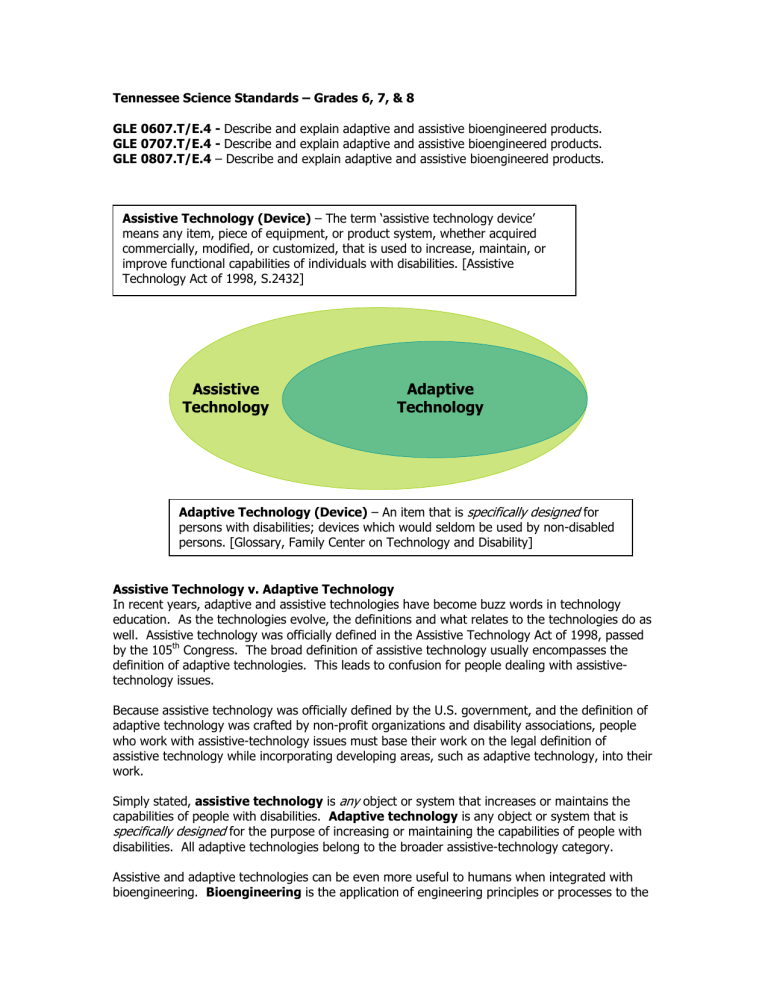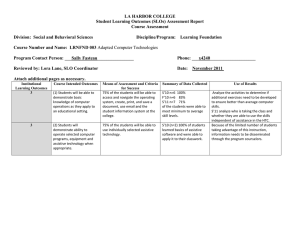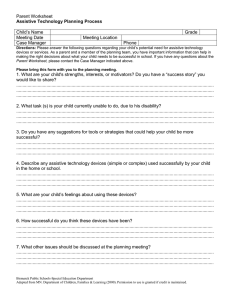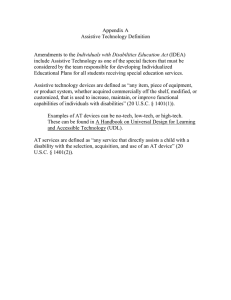Adaptive Technology Assistive Technology

Tennessee Science Standards – Grades 6, 7, & 8
GLE 0607.T/E.4 - Describe and explain adaptive and assistive bioengineered products.
GLE 0707.T/E.4 - Describe and explain adaptive and assistive bioengineered products.
GLE 0807.T/E.4 – Describe and explain adaptive and assistive bioengineered products.
Assistive Technology (Device) – The term ‘assistive technology device’ means any item, piece of equipment, or product system, whether acquired commercially, modified, or customized, that is used to increase, maintain, or improve functional capabilities of individuals with disabilities. [Assistive
Technology Act of 1998, S.2432]
Assistive
Technology
Adaptive
Technology
Adaptive Technology (Device) – An item that is specifically designed for persons with disabilities; devices which would seldom be used by non-disabled persons. [Glossary, Family Center on Technology and Disability]
Assistive Technology v. Adaptive Technology
In recent years, adaptive and assistive technologies have become buzz words in technology education. As the technologies evolve, the definitions and what relates to the technologies do as well. Assistive technology was officially defined in the Assistive Technology Act of 1998, passed by the 105 th Congress. The broad definition of assistive technology usually encompasses the definition of adaptive technologies. This leads to confusion for people dealing with assistivetechnology issues.
Because assistive technology was officially defined by the U.S. government, and the definition of adaptive technology was crafted by non-profit organizations and disability associations, people who work with assistive-technology issues must base their work on the legal definition of assistive technology while incorporating developing areas, such as adaptive technology, into their work.
Simply stated, assistive technology is any object or system that increases or maintains the capabilities of people with disabilities. Adaptive technology is any object or system that is specifically designed for the purpose of increasing or maintaining the capabilities of people with disabilities. All adaptive technologies belong to the broader assistive-technology category.
Assistive and adaptive technologies can be even more useful to humans when integrated with bioengineering. Bioengineering is the application of engineering principles or processes to the
fields of biology or medicine. Bioengineered technologies are specifically designed to change how the organism functions, which means they are adaptive technologies. However, because adaptive technologies are part of assistive technologies, bioengineered products can also be considered assistive technologies. The relationship can be better defined by limiting adaptive bioengineered technologies to devices or processes that are specifically designed for people with disabilities. Assistive bioengineered technologies are devices which were originally designed for the general population, but can be used by people with disabilities as well.
This integrated relationship can also be explained through examples. The examples below do
not form an exhaustive list of assistive and adaptive technologies.
Contact lenses
Crutches
Cochlear implants
Assistive
Technology
Adaptive
Technology
Mechanical organs
Artificial limbs
Hearing aids
Activity: Have students list other assistive and adaptive technologies.
Possible answers may include:
Assistive Technologies – wheelchairs, remote-controlled lift bed, etc.
Adaptive Technologies – hand-controlled car, Braille books, click-n-type (virtual keyboard), walking braces and/or stand, etc.



